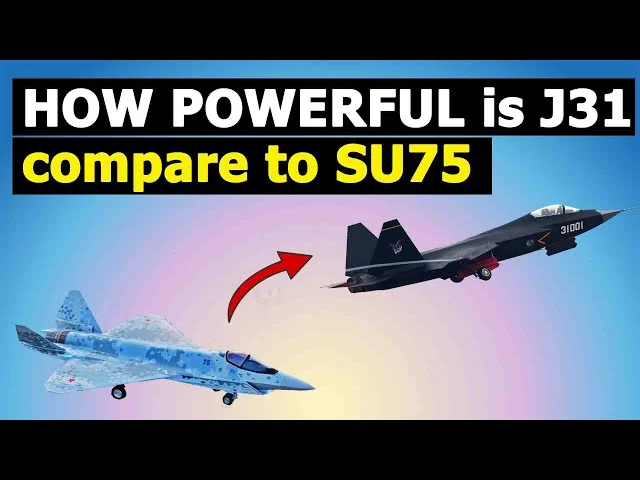Aviation
China’s J-31 To ‘Compete’ With Russia’s Su-75

China’s J-31 has entered the competitive arena alongside Russia’s Su-75 ‘Checkmate,’ challenging the American F-35 fighter jet, particularly in the affordable fifth-generation fighter market in developing countries. This shift comes in the wake of Pakistan’s announcement to acquire Chinese combat aircraft in the next few years.
The J-31, originally introduced as the FC-31, struggled to attract buyers initially, including China’s own military forces. However, geopolitical shifts, such as the intensifying US-China rivalry, prompted significant enhancements to the jet.
China’s aviation industry has adapted its marketing strategy to compete in the stealth fighter market, actively engaging in arms markets worldwide. The J-31’s advanced design, competitive pricing, and low political barriers to purchase have been highlighted by Chinese state media.
As the J-31 evolved through various prototype iterations, enhancing radar and stealth characteristics. The Su-75, featured in promotional material with international aviators, including those from India and the UAE, aims to court global partners. Russia has also disclosed plans for new features and shared manufacturing arrangements, emphasizing technology-sharing possibilities.
China’s J-31 boasts several advantages over its foreign competitors, such as the US F-35 and the Russian Su-75: cutting-edge technology, competitive pricing, lack of political movement, and comprehensive support.
In terms of specifications, the J-31 has a slightly smaller footprint than the Su-75 but boasts impressive capabilities, including a maximum takeoff weight of 28,000 kg. The J-31 is equipped with 2× WS-13 afterburning turbofans, generating 56.75 kN thrust each in dry conditions and 87.2 kN with afterburner. In comparison, the Su-75 features a single Saturn izdeliye 30 turbofan engine with an estimated thrust of 107.9 kN dry and 171.7 kN in afterburner. While both aircraft share similar maximum speeds, reaching Mach 1.8.
Essentially, the rivalry between China’s J-31 and Russia’s Su-75 in the accessible fifth-generation fighter market, especially within developing nations, is intensifying. The technical and commercial evolution of these planes, coupled with geopolitical developments, points towards a dynamic and competitive future in the global fighter jet arena.

Aviation
Boeing, Antonov to Collaborate on Defense Projects

– MOU represents Boeing’s commitment to work with Ukrainian industry
– Includes exploring opportunities for collaborating on in-country support of Unmanned Aerial Systems
A Memorandum of Understanding was signed today by Boeing and Antonov Company to investigate potential collaboration on defense-related projects.
“We’re happy to keep collaborating with the Antonov Company to help Ukraine’s economic development and expansion,” stated Ted Colbert, CEO and president of Boeing Defence, Space, & Security.
Airbus and the Antonov An-225: The Best Partnership:Click here
“This agreement demonstrates our ongoing efforts to find more opportunities to work with Ukrainian industry, which was underscored by our signing of the Ukrainian Defence Industry Compact earlier this year.”
The areas of potential collaboration identified in the agreement consist of training, logistical support and overhaul services for tactical Unmanned Aerial Systems utilized by the Ukrainian Armed Forces, which includes the ScanEagle. In addition, the companies will also explore opportunities for Antonov to provide engineering support to Boeing.
The six largest cargo aircraft ever built in the aviation industry:Click here
“A strong, innovative, and efficient defense industry is key to sustainable economic development and national security, and we are extremely excited to collaborate with Boeing,” said Ievhen Gavrylov, CEO of Antonov Company.
This agreement brings a whole new level of opportunity to implement the latest and most effective solutions – in addition to the possibility of future projects with Boeing in the aerospace and defense industry.”
-

 Travel1 week ago
Travel1 week agoAir India to Expand US Operations with Three New Routes After a Decade
-

 Travel2 weeks ago
Travel2 weeks agoWhy We Should Avoid These Stamps in a Passport
-

 Airlines1 month ago
Airlines1 month agoInvestigations Reveal Fake Chinese Titanium in Boeing and Airbus Jets
-

 Tech4 weeks ago
Tech4 weeks agoChina’s CATL Plans 1,800-Mile Electric Plane Launch by 2027
-

 Airport3 days ago
Airport3 days agoTop 10 Largest Airports in the World by Size
-

 Aerospace4 weeks ago
Aerospace4 weeks agoChina’s Fighter Jets Turn Wings into Autonomous Drones
-

 Airlines4 days ago
Airlines4 days agoAir India Rolls Out A350s for Delhi-New York JFK and Newark Routes
-

 Defence3 weeks ago
Defence3 weeks agoBoeing Enhances Chinook with New Engines and Block II Upgrades at $96 Million







